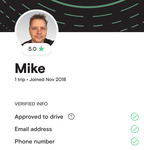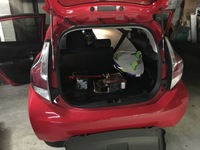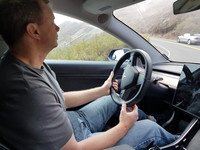 |
| Angelika/Mike Schilli |
|
|
|
Michael On vacation, we regularly drive around in rental cars in foreign cities. Typically, you book a "category" and not a specific car type. Once, at Sixt in Munich, I booked the "VW Golf GTI" class, but at the counter, they tried to give me an Opel Mandriva, a minivan for soccer moms. In Las Vegas, I once booked a Prius, but when I showed up, there was no Prius available. I made a fuss and was eventually appeased with a Japanese sports car, an Infiniti G37S. But I've always wanted to drive a Prius, the legendary hybrid car that Americans have been using to save gas for about 20 years, because the small gasoline engine keeps charging a large battery that then powers the car without gasoline during calm driving phases. While our Honda Fit guzzles a good eight liters per 100 km (30 miles/gal), a Prius manages with just four (60 miles/gal). I know, I know, in Germany people drive around in Matchbox cars that also only consume four liters (60 miles/gal), but in America, you can't get by with less than 100 horsepower.
Recently, the company Turo set out to break through the jungle of regulations and insurance for commercial car rentals (similar to how AirBnB did for hotels and Uber for taxis) and to act as an agency through which private individuals can rent out their cars to other private individuals. According to my research, the company already exists in Germany as well! Using a smartphone app, you can choose from a wide range of cars, plan a "trip," and then the renter ("Guest") meets with the owner ("Host") at the agreed upon pickup time for the key handover, and off you go. The app is used to take photos of the car at both pickup and return to ensure that the renter hasn't caused any new damage. Finally, both the renter and the owner rate each other with up to five stars so that future Turo customers know what kind of person they're dealing with.
Newer Prius models were available in San Francisco on Turo for about $60 per day, and I chose a rental with comprehensive insurance with a high deductible ($3000), which cost an additional $15 per day. Overall, a worthwhile fun for the weekend. For luxury cars, however, you pay a bit more, for example, around $150 for a Tesla Model S. But well, that's obviously much cheaper than the purchase price of $80,000. Since private cars mostly just stand around doing nothing, the business is equally rewarding for both renters and owners. The owner gets a part of their immense acquisition and maintenance costs reimbursed, and the renter has the opportunity to drive the car of their dreams, even if it's just for a day, saving themselves from buying a vehicle that quickly depreciates in value.
Pickup and return went smoothly in our self-test. The rental provider turned out to be an exceptionally nice person from a neighboring district, who even took the time to explain the various energy-saving modes of the vehicle to me and to give some good driving tips. It was fun to use the little car to complete our usual weekend routines: grocery shopping, going to Ikea, to the football field, and so on. The Prius C, the short version of the original model, is of course not a sports car, but you get used to it. After a while, driving becomes much more relaxed, and you automatically try to limit acceleration so that the display stays in Eco mode and the gasoline engine remains off -— well, maybe that's one reason why Prius drivers are notorious for being slowpokes. I even tested whether my large, 8 foot long surfboard would fit inside (check!) and a new desk chair bought at Ikea could be effortlessly inserted through the tailgate onto the enlarged loading area by folding down the seats. A well-constructed car, I must say.
How is the rental car insured with Turo now? As always, it's important to look closely at the fine print and to understand the difference between liability insurance and comprehensive/collision insurance. In America, liability insurance usually stays with the car, so if, for example, we lend our car to a friend and they have an accident, our liability insurance covers the third-party damage -— though our premiums would likely skyrocket afterwards. If a private individual rents out their car on Turo, their liability insurance generally puts a stop to it, as commercial car rental is usually explicitly excluded in the contract. However, Turo has taken precautions and arranged a group insurance policy with a major American insurer (Liberty Mutual), which provides liability coverage of one million dollars for each car rented through Turo.
Interestingly, Turo also offers renters various insurance packages that primarily regulate the deductible for comprehensive insurance but allegedly also affect liability, which varies depending on the package between one million dollars and the much lower state-mandated minimum (in California, for example, only $15,000 per person for personal injury, $30,000 per accident, and $5,000 for property damage). The whole thing smells like total insurance chaos because, in the event of an accident, up to four different insurers could be involved: the liability insurance of the owner, Turo's group insurance, the renter's liability insurance (if they have one for their private car that also covers rental cars), and the comprehensive insurance package the renter may have purchased from Turo. In the event of an accident, the renter can undoubtedly expect a few rounds of rigamarole on the phone. On the other hand, the comprehensive insurance, which covers damages to the rental car, costs between 18% and 80% of the rental price, depending on the deductible. At 18%, the renter has to pay $3,000 out of pocket for car damage before the insurance kicks in. At 80%, the insurance covers everything, but this option is only available for vehicles that cost less than $35,000.
We were very satisfied with our rental; even driving in traffic jams is fun with the Prius because it automatically decelerates slightly and charges the battery with the energy gained when you simply take your foot off the gas pedal, without having to constantly step on the brake when the car in front is driving erratically. However, the colorful graphic display on the dashboard probably leads Prius drivers to accelerate very slowly to keep the Eco-Meter in the green zone -- which likely contributes to the aforementioned slowpoke image. But if you step on it properly, it does have some power; after all, 99 horsepower is nothing to sneeze at.
For our second Turo trip, I booked a Tesla Model 3. With the 100 miles included in the price, I planned a route heading north over the Golden Gate Bridge, then down the winding mountain road to Muir Beach, where we did a short hike. Then we went up to Point Reyes Station for lunch, over to Nicasio to our favorite cheese factory, and back over the bridge into the city. That was 90 miles, and the Tesla's battery indicator went from 66% to 30%. The little car has "only" 270 horsepower, but it accelerates completely linearly and so strongly that you feel pressed against the seat like on a roller coaster. I left a series of German luxury sports cars in the dust.
Before driving a Tesla, you should definitely watch a few explanatory videos. An average person might not even be able to open the driver's door with its quirky door handle. Once in the driver's seat, you look for the gear lever and find out that Tesla has repurposed the windshield wiper lever to the right of the steering wheel as the gear lever: pull up to go in reverse, push down to go forward. You turn on the windshield wipers on the tablet in the center console by swiping and tapping through menus. You press the gear lever down twice to activate the autopilot, which maintains the distance to the car in front and keeps the lane on the freeway. This function even initiates overtaking on its own when you activate the turn signal, but I found that too risky to try out in traffic. Before returning the vehicle, the owner wanted me to take the Tesla through an automatic car wash, and when I got there, I suddenly remembered that you have to put it in "N" for Neutral (i.e., neutral gear), but how do you do that with a lever that only has "R" for Reverse and "D" for Drive? Luckily, I saw a car wash attendant in front of the already dangerously rotating brush, and I rolled down the window and quickly asked how to put a Tesla in "N." He was familiar with the problem and simply reached in, pulled the lever just a bit, not all the way down, and waited two seconds until the tablet displayed "N." You have to figure that out first!

















